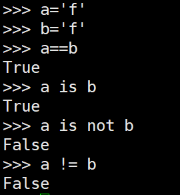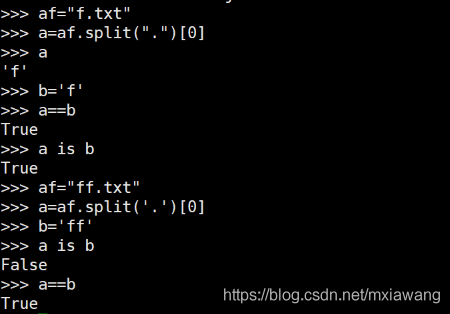在python中,判断两个变量是否相等或一样,可以使用==或者is来判断;判断不一样可以使用 is not。
示例
使用注意事项
1.有时候两个字符串打印出来看着一样,但是判断却是False?如果两个字符串末尾有其他符号,比如回车‘\n’,print的时候无法发现的,所以需要strip:
a=a.strip()
b=b.strip()
if a==b:
print "True"2.有时候==判断是 True ,is 判断却是 False?
这是因为两个字符串来自不同的内存块,内存地址不一样
id() 函数用于获取对象的内存地址。
(ob1 is ob2) 等价于 (id(ob1) == id(ob2)) id函数可以获得对象的内存地址,如果两个对象的内存地址是一样的,那么这两个对象肯定是一个对象。和is是等价的.
3.还有一种情况是两个对象用is判断是False,用id判断却是True。原理比较复杂,如下:
In [1]: def bar(self, x):
...: return self.x + y
...:
In [2]: class Foo(object):
...: x = 9
...: def __init__(self ,x):
...: self.x = x
...: bar = bar
...:
In [3]: foo = Foo(5)
In [4]: foo.bar is Foo.bar
Out[4]: False
In [5]: id(foo.bar) == id(Foo.bar)
Out[5]: True真实情况是当执行.操作符的时候,实际是生成了一个proxy对象,foo.bar is Foo.bar的时候,两个对象顺序生成,放在栈里相比较,由于地址不同肯定是False,但是id(foo.bar) ==id(Foo.bar)的时候就不同了,首先生成foo.bar,然后计算foo.bar的地址,计算完之后foo.bar的地址之后,就没有任何对象指向foo.bar了,所以foo.bar对象就会被释放。然后生成Foo.bar对象,由于foo.bar和Foo.bar所占用的内存大小是一样的,所以又恰好重用了原先foo.bar的内存地址,所以id(foo.bar) == id(Foo.bar)的结果是True。
下面内容由邮件Leo Jay大牛提供,他解释的更加通透。
用id(expression a) == id(expression b)来判断两个表达式的结果是不是同一个对象的想法是有问题的。
foo.bar 这种形式叫 attribute reference [1],它是表达式的一种。foo是一个instance object,bar是一个方法,这个时候表达式foo.bar返回的结果叫method object [2]。根据文档:
When an instance attribute is referenced that isn’t a data attribute,
its class is searched. If the name denotes a valid class attribute
that is a function object, a method object is created by packing
(pointers to) the instance object and the function object just found
together in an abstract object: this is the method object.
foo.bar本身并不是简单的名字,而是表达式的计算结果,是一个 method object,在id(foo.bar)这样的表达式里,method object只是一个临时的中间变量而已,对临时的中间变量做id是没有意义的。
一个更明显的例子是,
print id(foo.bar) == id(foo.__init__) 输出的结果也是True看 id 的文档[3]:
Return the “identity” of an object. This is an integer (or long
integer) which is guaranteed to be unique and constant for this object
during its lifetime. Two objects with non-overlapping lifetimes may
have the same id() value. CPython implementation detail: This is the
address of the object in memory.
只有你能保证对象不会被销毁的前提下,你才能用 id 来比较两个对象。所以,如果你非要比的话,得这样写:
fb = foo.bar
Fb = Foo.bar
print id(fb) == id(Fb)即把两个表达式的结果绑定到名字上,再来比是不是同一个对象,你才能得到正确的结果。
is表达式 [4] 也是一样的,你现在得到了正确的结果,完全是因为 CPython 现在的实现细节决定的。现在的is的实现,是左右两边的对象都计算出来,然后再比较这两个对象的地址是否一样。万一哪天改成了,先算左边,保存地址,把左边释放掉,再算右边,再比较的话,你的is的结果可能就错了。官方文档里也提到了这个问题 [5]。我认为正确的方法也是像id那样,先把左右两边都计算下来,并显式绑定到各自的名字上,然后再用is判断。
参考:https://blog.csdn.net/weixin_32820767/article/details/82320914